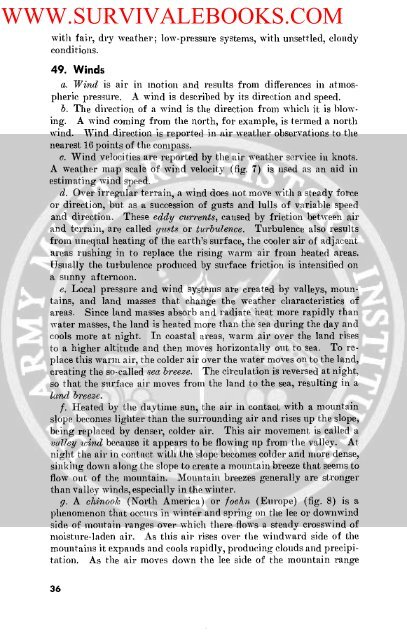1959 US Army Vietnam War Terrain Intelligence ... - Survival Books
1959 US Army Vietnam War Terrain Intelligence ... - Survival Books
1959 US Army Vietnam War Terrain Intelligence ... - Survival Books
You also want an ePaper? Increase the reach of your titles
YUMPU automatically turns print PDFs into web optimized ePapers that Google loves.
WWW.SURVIVALEBOOKS.COM<br />
with fair, dry weather; low-pressure systems, with unsettled, cloudy<br />
conditions.<br />
49. Winds<br />
a. Wind is air in motion and results from differences in atmospheric<br />
pressure. A wind is described by its direction and speed.<br />
b. The direction of a wind is the direction from which it is blowing.<br />
A wind coming from the north, for example, is termed a north<br />
wind. Wind direction is reported in air weather observations to the<br />
nearest 16 points of the compass.<br />
c. Wind velocities are reported by the air weather service in knots.<br />
A weather map scale of wind velocity (fig. 7) is used as an aid in<br />
estimating wind speed.<br />
d. Over irregular terrain, a wind does not move with a steady force<br />
or direction, but as a succession of gusts and lulls of variable speed<br />
and direction. These eddy currents, caused by friction between air<br />
and terrain, are called gusts or turbulence. Turbulence also results<br />
from unequal heating of the earth's surface, the cooler air of adjacent<br />
areas rushing in to replace the rising warm air from heated areas.<br />
Usually the. turbulence produced by surface friction is intensified on<br />
a sunny afternoon.<br />
e. Local pressure and wind systems are created by valleys, mountains,<br />
and land masses that change the weather characteristics of<br />
areas. Since land masses absorb and radiate heat more rapidly than<br />
water masses, the land is heated more than the sea during the day and<br />
cools more at night. In coastal areas, warm air over the land rises<br />
to a higher altitude and then moves horizontally out to sea. To replace<br />
this warnm air, the colder air over the water moves on to the land,<br />
creating the so-called sea breeze. The circulation is reversed at night,<br />
so that the surface air moves from the land to the sea, resulting in a<br />
land breeze.<br />
f. Heated by the daytime sun, the air in contact with a mountain<br />
slope becomes lighter than the surrounding air and rises up the slope,<br />
being replaced by denser, colder air. This air movement is called a<br />
valley wind because it appears to be flowing up from the valley. At<br />
night the air in contact with the slope becomes colder and more dense,<br />
sinking down along the slope to create a mountain breeze that seems to<br />
flow out of the mountain. Mountain breezes generally are stronger<br />
than valley winds, especially in the winter.<br />
g. A chinook (North America) or foehn. (Europe) (fig. 8) is a<br />
phenomenon that occurs in winter and spring on the lee or downwind<br />
side of moutain ranges over which there flows a steady crosswind of<br />
moisture-laden air. As this air rises over the windward side of the<br />
mountains it expands and cools rapidly, producing clouds and precipitation.<br />
As the air moves down the lee side of the mountain range<br />
36

















